Claude Cahun, born Lucy Renee Mathilde Schwob in 1894, was a French writer, photographer and artist recognized for her personal and political work that frequently explored gender and sexuality.
From 1912, she crafted self-portraits that challenged gender boundaries with surreal visual aesthetics, often donning various disguises.
In the early 1920s, Cahun and her partner, Suzanne Malherbe, collaborated on written pieces, collages, photomontages and sculptures, while also fervently campaigning against the Nazis.
Cahun‘s association with the surrealist movement began in 1932, leading to her participation in numerous exhibitions.
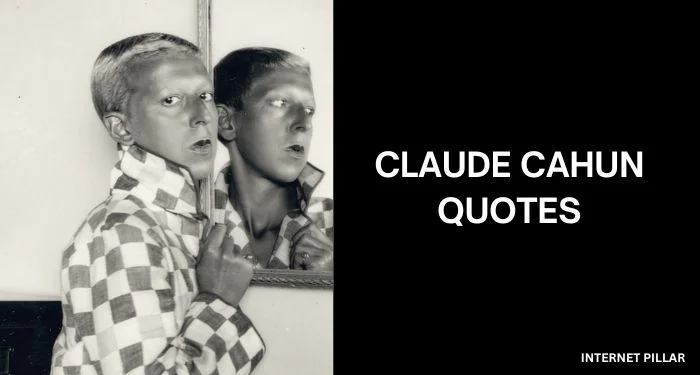
Her work, especially her self-portraits, paved the way for future artists by showcasing the chameleonic nature of women’s identities in a time dominated by male surrealists.
Cahun’s daring self-expression, utilizing body language, attire and varied backgrounds, has been celebrated in exhibitions worldwide. She passed away in 1954.
Related: Walker Evans Quotes from the American Photographer and Edward Weston Quotes from the American Photographer
I have handpicked some of the top quotes by Claude Cahun in this article.
Best Claude Cahun Quotes
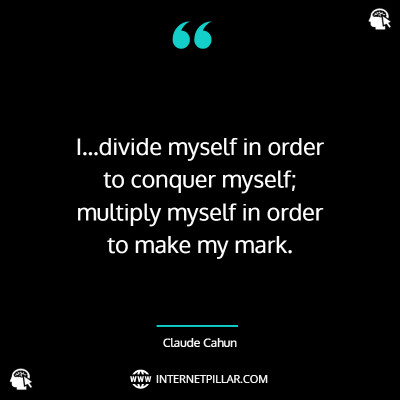
I…divide myself in order to conquer myself; multiply myself in order to make my mark. ~ Claude Cahun.

If I vibrate with vibrations other than yours, must you conclude that my flesh is insensitive? ~ Claude Cahun.
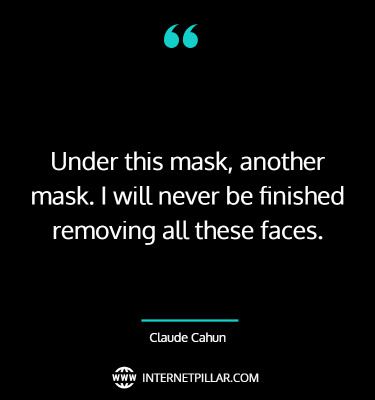
Under this mask, another mask. I will never be finished removing all these faces. ~ Claude Cahun.
The blood orange has its admirer, who suck it smugly. Cooks stalk it; they’d like to put it in some tartare sauce. However, some, like me, turn their noses up. In silence they mould bits of bread into balls, delighting in their work, then chuck them in God’s face. ~ Claude Cahun.
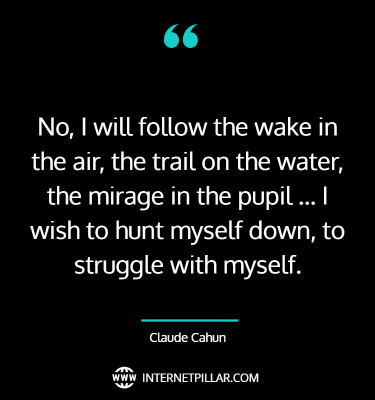
No, I will follow the wake in the air, the trail on the water, the mirage in the pupil … I wish to hunt myself down, to struggle with myself. ~ Claude Cahun.
Famous Claude Cahun Quotes
Although I had a lot of time to get acquainted with myself, my knowledge about me is fragmentary. I could tell you all about my life, but all you would get would be a mere reference to my person. I am both subject and object of my history. ~ Claude Cahun.
Individualism? Narcissism? Of course. It is my strongest tendency, the only intentional constancy [fidelity] I am capable of…. Besides, I am lying; I scatter myself too much for that. ~ Claude Cahun.
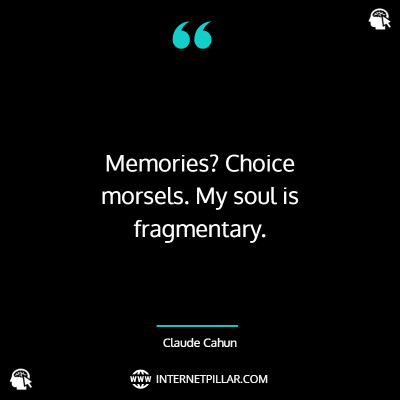
Memories? Choice morsels. My soul is fragmentary. ~ Claude Cahun.
You have told me to write a confession because you know only too well that this is currently the only literary task that might seem to me first and foremost realizable, where I feel at ease, permit myself a direct link, contact with the real world, with the facts. ~ Claude Cahun.
If there is horror, it is for those who speak indifferently of the next war. If there is hate, it is for hateful qualities, not nations. If there is love, it is because this alone kept me alive. ~ Claude Cahun.
Top Claude Cahun Quotes
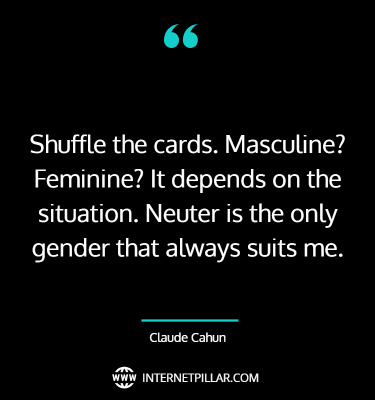
Shuffle the cards. Masculine? Feminine? It depends on the situation. Neuter is the only gender that always suits me. ~ Claude Cahun.
Realities disguised as symbols are, for me, new realities that are immeasurably preferable. I make an effort to take them at their word. To grasp, to carry out the diktat of images to the letter. ~ Claude Cahun.
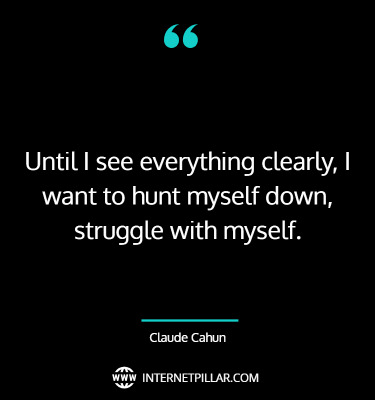
Until I see everything clearly, I want to hunt myself down, struggle with myself. ~ Claude Cahun.
I’m obsessed with the exception. I see it as bigger than nature. It’s all I see. The rule interests me only for its leftovers with which I make my swill. In this way, I deliberately downgrade myself. Too bad for me. ~ Claude Cahun.
So these were the 15 top Claude Cahun quotes and sayings.
If you like these quotes and sayings, then you can also read my other posts on Ava Gardner quotes and Maria Sabina quotes.
Short Biography of Claude Cahun
Claude Cahun, originally named Lucy Schwob, was a notable French surrealist artist and writer, renowned for her self-portraits and gender fluidity, often captured through her androgynous appearance.
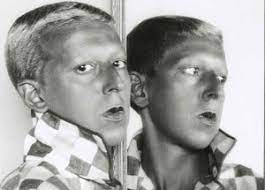
Born in 1894 into a literary Jewish family, she faced her mother’s mental illness early on and encountered antisemitism, which led her to study in Paris.
Adopting the name Claude Cahun around 1914, she moved to Paris with her partner and step-sister Suzanne Malherbe (Marcel Moore), where they became integral parts of the avant-garde community.
| Full Name | Lucy Renee Mathilde Schwob |
| Born | 25 October 1894, Nantes, France |
| Died | 8 December 1954 (age 60 years), Saint Helier, Jersey< |
| Resting Place | St Brelade’s Church |
| Known For | Photography, writing, sculpture, collage |
| Movement | Surrealism |
| Artworks | Entre nous (Between Us), Untitled (I am in training, don’t kiss me), Untitled (Self-Portrait), Selfportrait |
| Parents | Mary-Antoinette Courbebaisse |
| Partner | Marcel Moore (1909–1954) |
Cahun’s work, blending photography, writing, and theatre, often challenged traditional gender roles and included significant contributions to the surrealist movement.
Her resistance activities during WWII further highlighted her multifaceted life.
Despite her innovative work, Cahun’s recognition beyond France has been limited, though recent exhibitions have begun to acknowledge her influence in surrealism and gender studies.
Quick Facts about Claude Cahun
- Claude Cahun, born Lucy Renee Mathilde Schwob, was a French surrealist artist.
- Cahun adopted the pseudonym Claude Cahun in 1914.
- Known for self-portraits, Cahun explored various personas.
- Cahun’s work challenged traditional gender roles.
- Cahun referred to herself as “elle” (she) but identified as gender fluid.
- Active in the resistance during WWII.
- Born into a wealthy, literary Jewish family in Nantes, 1894.
- Raised by her grandmother after her mother’s mental illness.
- Experienced antisemitism, leading to schooling in Surrey, England.
- Attended the University of Paris, Sorbonne.
- Began self-portraiture at 18 and continued into the 1930s.
- Changed his name from Lucy Schwob to Claude Cahun around 1914.
- Lived with lifelong partner Suzanne Malherbe (Marcel Moore) in Paris.
- Cahun and Moore became step-sisters in 1917.
- The duo collaborated on various artistic projects.
- Hosted artists’ salons attended by notable figures.
- Cahun’s work included writing, photography, and theatre.
- Self-portraits often featured androgynous appearances.
- Published works include “Heroines” and “Aveux non avenus.”
- Joined surrealist groups, participated in exhibitions in the 1930s.
- David Bowie highlighted Cahun’s work in a 2007 New York exhibition.
- Collaboration with Moore is often unrecognized, Moore possibly behind the camera.
- Settled in Jersey in 1937, became WWII resistance workers.
- Used dark humor in resistance efforts against German occupation.
- Arrested and sentenced to death in 1944; the sentence was not carried out.
- Cahun’s health deteriorated after jail, died in 1954.
- Cahun and Moore buried together in St Brelade’s Church, Jersey.
- Work largely unrecognized until 40 years posthumously.
- Seen as a challenge to gender, beauty, and logic norms.
- Twenty-first-century writings describe Cahun and Moore as “prototransgender artists.”
- Paris named a street after Cahun and Moore in 2018.
- Rupert Thomson’s 2018 novel based on Cahun and Moore’s lives.
- Jeffrey H. Jackson documented their WWII activism in “Paper Bullets.”
- Google honored Cahun with a Doodle on her 127th birthday in 2021.
- Kaz Rowe’s 2023 graphic novel biography explores Cahun’s life and work.
Top Questions about Claude Cahun
A: Claude Cahun was a French surrealist known for their work as a photographer, sculptor, and writer. Born Lucy Renee Mathilde Schwob, they adopted the pseudonym Claude Cahun in 1914 and are celebrated for their self-portraiture and writings that explore gender fluidity.
A: Claude Cahun expressed a fluid gender identity, often stating that their true gender varied with the situation. They are quoted as saying, “Masculine? Feminine? It depends on the situation. Neuter is the only gender that always suits me,” reflecting their non-binary view on gender.
A: Claude Cahun, alongside their partner Marcel Moore, engaged in resistance activities against the German occupation in Jersey during World War II. They produced anti-German fliers, often using dark humor and creative tactics to spread their message and undermine Nazi authority.
A: Born into a literary Jewish family in Nantes, Cahun’s early life was marked by her mother’s mental illness and subsequent internment, leading to a childhood spent with her grandmother. Experiencing antisemitism at a young age, Cahun later attended a private school in Surrey and the University of Paris, Sorbonne.
A: Claude Cahun and Marcel Moore, who became step-sisters after their parents’ marriage, shared an artistic and romantic partnership. They collaborated on various projects, including writing, sculpture, and photography, often challenging traditional gender roles through their work.
A: Cahun’s work, particularly in photography and theatre, played with themes of androgyny, identity, and the deconstruction of gender norms. Their self-portraits often depicted them in various roles, blurring gender lines and challenging societal expectations.
A: Claude Cahun has been celebrated posthumously through exhibitions and retrospectives, such as the 1994 Institute of Contemporary Arts exhibition in London and a multi-media exhibition curated by David Bowie in New York in 2007. Their work continues to inspire discussions on gender, identity, and resistance.
A: Claude Cahun has been referred to by both “she/her/hers” and “they/them/theirs.” The former was used during Cahun’s lifetime, while the latter reflects their complex relationship with gender identity.
A: In 1944, Claude Cahun and their partner were arrested, sentenced to death, but the sentence wasn’t executed due to the liberation of the island in 1945. Unfortunately, Cahun’s health deteriorated from the ordeal, leading to their death in 1954.
A: Claude Cahun is recognized for their contribution to the Surrealist movement in Paris during the 1920s and 1930s, especially through their work that questioned traditional notions of gender, sexuality, and identity.
A: Yes, Claude Cahun was a French surrealist, known for their work as a photographer, sculptor, and writer, actively contributing to the movement in the early 20th century.
A: Claude Cahun started exploring photography at the age of eighteen in 1912, primarily focusing on self-portraits, and continued this artistic exploration into the 1930s.
A: In 1914, originally named Lucy Renée Mathilde Schwob, they chose the name Claude Cahun, a gender-neutral choice reflecting their nuanced identity and distancing from traditional gender roles.



